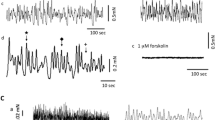Abstract
-
1.
Stimulation in vivo of the cervical vagus nerve produces contraction of the gallbladder of the guinea-pig. Following block of this response by atropine, a relaxation is revealed which is not affected by the adrenergic neurone blocker guanethidine. The relaxation is blocked by hexamethonium, indicating that the non-adrenergic inhibitory neurones are in the bladder wall and are activated via nicotinic synapses.
-
2.
Stimulation of the intramural nerves supplying the bladder in vitro confirms the existence of nonadrenergic inhibitory neurones: relaxations appearing in response to stimulation of intramural nerves in the presence of atropine are abolished by tetrodotoxin and xylocaine, and are unaffected by guanethidine, phentolamine and propranolol.
-
3.
There is evidence to suggest that these inhibitory neurones are purinergic.
-
(a)
The nerve mediated relaxation is mimicked by ATP and adenosine, blocked by quinidine (in doses which block the response to ATP, but not isoprenaline) and potentiated by dipyridamole; ‘rebound contractions’ following the nerve-mediated relaxations are blocked by indomethacin, in a manner comparable to that shown for ‘rebound contractions’ following purinergic inhibitory responses of the intestine.
-
(b)
Nerve cell bodies and fibres exhibit fluorescence after incubation in quinacrine (which is known to bind ATP); this fluorescence is unaffected by chemical sympathectomy with 6-hydroxydopamine.
Similar content being viewed by others
References
Abrahamsson, H., Jansson, G.: Vagol-vagal gastro-gastric relaxation in the cat. Acta Physiol. Scand.88, 289–295 (1973)
Bülbring, E.: Measurements of oxygen consumption in smooth muscle. J. Physiol. (Lond.)122, 111–134 (1953)
Burnstock, G.: Evolution of the autonomic innervation of visceral and cardiovascular systems in vertebrates. Pharmacol. Rev.21, 247–324 (1969)
Burnstock, G.: Purinergic nerves. Pharmacol. Rev.20, 509–581 (1972)
Burnstock, G.: Purinergic transmission. In: Handbook of Psychopharmacology (L. Iversen and S. Snyder, eds.), pp. 131–194. New York: Plenum Press 1975
Burnstock, G.: Do some nerve cells release more than one transmitter? Neuroscience1, 239–248 (1976)
Burnstock, G., Campbell, G., Satchell, D. G., Smythe, A.: Evidence that adenosine triphosphate or a related nucleotide is the transmitter substance released by non-adrenergic inhibitory nerves in the gut. Br. J. Pharmacol.40, 668–688 (1970)
Burnstock, G., Cocks, T., Paddle, B., Staszewska-Barczak, J.: Evidence that prostaglandin is responsible for the ‘rebound contraction’ following stimulation of non-adrenergic, noncholinergic (purinergic) inhibitory nerves. Eur. J. Pharmacol.31, 360–362 (1975)
Burnstock, G., Cocks, T., Crowe, R., Kasakov, L.: Purinergic innervation of the guinea-pig urinary bladder. Br. J. Pharmacol.63, 125–138 (1978)
Code, C. F., Schlegel, J. F.: Motor action of the oesophagus and its sphincters. In: Handbook of physiology, Chap. 90, Sec. 6: Alimentary canal, Vol. IV, pp. 1821–1839. Washington D.C.: American Physiological Society 1968
Costa, M., Furness, J. B.: The innervation of the internal anal sphincter in the guinea-pig. Rend. Gastroenterol.5, 47–58 (1973)
Davison, J. S., Fösel, S.: Interactions between vagus nerve stimulation and pentagastrin or secretin on the guinea-pig gallbladder. Digestion13, 251–254 (1975)
Falck, B., Hillarp, N. A., Thieme, G., Torp, A.: Fluorescence of catecholamines and related compounds condensed with formaldehyde. J. Histochem. Cytochem.10, 348–354 (1962)
Furness, J. B., Costa, M.: The participation of enteric inhibitory nerves in accommodation of the intestine to distension. Clin. Exp. Pharmacol. Physiol.4, 37–41 (1977)
Hirst, G. D. S., McKirdy, H. C.: A nervous mechanism for descending inhibition in guinea-pig small intestine. J. Physiol. (Lond.)238, 129–143 (1974)
Irvin, J. L., Irvin, E. M.: The interaction of quinacrine with adenine nucleotides. J. Biol. Chem.210, 45–56 (1954)
Karnovsky, M. J., Roots, L.: A direct colouring thiocholine method for cholinesterases. J. Histochem. Cytochem.12, 219–221 (1964)
Lorez, H. P., Da Prada, M., Launay, J. M.: Fluorescence microscopy of 5HT organelles in normal and storage pool deficient blood platelets (P) Abstract, 9th Annual meeting of the Unions of Swiss Societies of Experimental Biology, Zürich April, 1977
Malmfors, T., Thoenen, H.: In: 6-Hydroxydopamine and catecholamine neurones (T. Malmfors and H. Thoenen, eds.). Amsterdam, London: North Holland. Publ. Co. 1971
Olson, L., Alund, M., Norberg, K. A.: Fluorescence-microscopical demonstration of a population of gastrointestinal nerve fibres with a selective affinity for quinacrine. Cell. Tiss. Res.171, 407–423 (1976)
Said, S. I.: Progess in gastroenterology. V. Vasoactive intestinal peptide (VIP). Gastroenterology67, 735–737 (1974)
Said, S. I.: Vasoactive intestinal polypeptide (VIP). Current status. In: Gastrointestinal hormones (J. C. Thompson, ed.), Austin, U.S.A.: Texas Univ. Press 1975
Satchell, D. G., Lynch, A., Bourke, P., Burnstock, G.: Potentiation of the effects of exogenously applied ATP and purinergic nerve stimulation on the guinea-pig taenia coli by dipyridamole and hexobendine. Eur. J. Pharmacol.19, 343–359 (1972)
Stasiewicz, J., Wormsley, K. G.: Functional control of the biliary tract. Acta Hepato-gastroenterol.21, 450–468 (1974)
Sundler, F., Alumets, J., Hakanson, R., Ingemansson, S., Fahrenkrug, J., Schaffalitzky de Muckadell, O.: VIP innervation of the gallbladder. Gastroenterology72, 1375–1377 (1977)
Vane, J. R.: Inhibition of prostaglandin synthesis as a mechanism of action of aspirin-like drugs. Nature New Biol.231, 232–235 (1971)
Author information
Authors and Affiliations
Rights and permissions
About this article
Cite this article
Davison, J.S., Al-Hassani, M., Crowe, R. et al. The non-adrenergic, inhibitory innervation of the guinea-pig gallbladder. Pflugers Arch. 377, 43–49 (1978). https://doi.org/10.1007/BF00584372
Received:
Issue Date:
DOI: https://doi.org/10.1007/BF00584372




